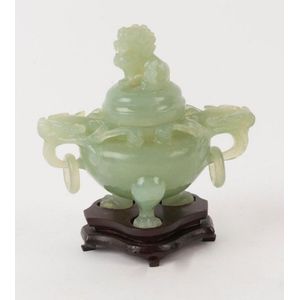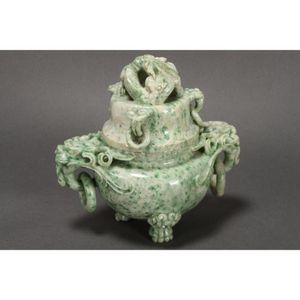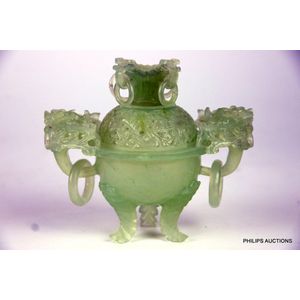
20th Century Chinese Carved Jade Censer, 12 cm High
A Chinese carved jade censer, 20th century, 12 cm high

Chinese Pale Celadon & Grey Jade Archaistic Style Dragon Censer
Chinese pale celadon & mottled grey jade archaistic style censer. 18th/19th century finely carved diapers and taotie masks with dragon handles. Lacking cover. Provenance: Estates late Adolphe and Asra Alexander, a German-Thai couple involved with…

Carved Jade Dragon Censer from 20th Century China
A Chinese carved jade dragon censer, 20th century, 14 cm high

Celadon Jade Censer from Hong Kong, 1970
A celadon jade censer, 12 cm wide. Provenance: an old private collection, Sydney, Australia, acquired from Kowloon, Hong Kong, 1970. 1970

Chinese Jade Longevity Censer Top with Deer and Foliage
A Chinese reticulated jade longevity carving of a censer top. Qing Dynasty the pale celadon jade stone with brown inclusion, carved with the Daoist emblem of longevity on each side, one deer in brown and one in celadon, beneath the dense foliage of a tree…

Chinese Jade Animals and Miniature Censer Set
Three Chinese carved jade animals, a miniature censer and pot (5 items), 20th century, the horse 10 cm long

Archaistic Jade Censer and Plaque Set
An archaistic jade censer and a plaque 28.2 cm diam. and 25.2 cm high (2). Provenance: Previously from a Japanese private collection

Dragon-handled Jade Censer with Lion Finial
A Chinese carved green jade lidded censer with dragon handles and Chi-Long lion finial, 20th century, 13 cm high overall

Chinese Jade Censer with Mythical Animal Motifs
A Chinese carved gray jade censer with dark russet inclusions. Adorned with mythical animal face masks, Chi-Long lion cub finial with carved lion feet, Kui dragon handles and archaic Taotie panels, Qing Dynasty 19th/20th century, 21 cm high, 22 cm wide

Chinese Nephrite Lion Censer with Lid
Framed Chinese carved nephrite lidded censer with lion detail, diameter 62 cm x 47 cm

Qing Dynasty Bronze Censer with Xuande Mark and Jade Cover
A bronze censer Qing dynasty, 19th century, of bombe form supported on tripod conical feet, set on the flared mouth with two upright loop handles, the base with an apocryphal six-character mark of Xuande in a rectangular recess, jade-knopped wood cover…

Spinach Jade Lion Censer with Reticulated Cover
Chinese dark spinach jade censer. With reticulated domed cover, twin lion mask ring handles. On three lion paw feet. Height 13 cm

Archaistic Celadon Jade Square Censer with Reticulated Cover
An archaistic celadon jade square censer, 18th/ 19th century fitted with reticulated cover and stand, box, 7.5 cm high, 370g, 16.7 cm high (overall). Provenance: R&V Tregaskis Oriental Art, Sydney. Private collection, Sydney. Bonhams, Fine Furniture,…

Chinese Twin Handled Jade Censer with Dragon Handles
Good Chinese jade twin handled censer and cover, of baluster form, the domed cover carved with a frieze of taoist elements, flanked by dragon mask handles, above a similar frieze raised on three feet, length 17 cm

Chinese Dragon Jadeite Censer with Cover and Handles
Large Chinese carved jadeite twin handled censer and cover, with a carved dragon finial, surrounded by three drop ring handles above a baluster shaped body, with dragon head handles on three paw feet, in tones of emerald green on white, height 19 cm.…

Translucent Jade Censer with Lion Handles and Pierced Dome Cover
A fine jade ornamental censer, in translucent celadon jade, the bowl raised upon tripod foliate legs and having well carved lion handles with rings, surmounted by a finely pierced, dome cover with arabesque designs and having a floral finial also with…

Bird Carved Chinese Greenstone Censer with Rings
Chinese greenstone censer possibly a jade or a nephrite and featuring a carved bird on a branch and carvings with attached rings. Height 19 cm

Qing Dynasty Jade Twin Handled Censer with Wooden Cover
Chinese Qing Dynasty jade twin handled censer and wooden cover, the circular cover set with jadeite finial, above a flared lip, carved with shou motifs, flanked by dragon handles, raised on a circular foot, in tones of black, green and grey, a/f, 7.5 cm x…

Chinese Jade and Hardstone Bird Figurines and Censer
Chinese carved jade and hardstone figural groups of birds, comprising three birds and flowers figure groups, a covered vase and an intricately carved censer with rooster handles (5), height 26 cm, (censer). Provenance: Canton world trade, c. 1980 (censer)…

Dragon Carved Jade Censer with Stand
Jade censer and cover boldly carved with dragon, urn and animal emblems on stand, 32 cm height

Green Jade Censer with Stand
Carved green jade censer and stand (ex Falk collection), 12 cm wide, 14 cm high including stand

Dragon Jade Censer with Lid
Chinese green / white jade lidded censer of a dragon, 13 cm high, 8 cm wide, 10 cm deep

Celadon Jade Censer from Qing Dynasty
A Chinese celadon jade censer Qing Dynasty, 20th century 13 cm high

Mid 20th Century Chinese Jade Lidded Censer with Stand
A Chinese carved jade lidded censer, mid 20th century height 20 cm - with stand

Dragon-handled Jade Censer with Multi-Tiers
Large celadon jade multi-tiered censer, substantial carved jade censer, Consisting of two tiered main censer bowls with Oversailing dragon handles and rings. The main censer bowls are carved with foliate dragons & the main cover with a dragon cartouche &…

Dragon Carved Jade Censer on Stand
A Chinese nephrite jade censer, in an archaic form, 19th/20th century, finely carved with dragons on lid & double dragons with loose rings the on base, raised on taotie mask clawed feet, on fitted stand, height 22, length 18 cm

Chinese Green Hardstone Dragon Censer with Cover
A Chinese green hardstone censer and cover, possibly jade, modelled as an urn raised on a stand surmounted by a multi-tiered cover, the basin cover embellished with dragon handles with captured rings. Height 50 cm

Mughal-style Celadon Jade Reticulated Censer and Cover
A Mughal-style celadon jade reticulated censer and cover, 20th century, the shallow rounded sides carved to simulate basket weave supported on a pierced splayed foot, and rising to the similarly pierced broad everted rim, set with two chrysanthemum flower…

Chinese Jade Lions and Smoky Censer
A pair of Chinese jade lions and a smoky jade censer, the fantastic winged lions in an animated pose, in vigorously veined celadon jade with black and iron red inclusions, and a translucent smoky tri-footed censer bowl with ringed lion handles and a…

Chinese Jade Censer with Dragon Handles and Lion Cover
A Chinese pale jade censer and cover, squat circular shape raised on three feet and with dragon and ring handles issuing from the sides, the domed cover surmounted by a temple lion. Raised on carved and pierced shaped wooden base. Height 18.5 cm

Enamelled Silver Dragon Censer with Jade and Coral Inlay
Vintage silver enamelled censer designed with double dragon handle with balls, coral inaly to the lid with enamelled cloud detail. Turquoise with jade inlay to the body with phoenix decoration, & two jade carved panels, all standing on a trifooted stand.…

Celadon Jade Archaistic Two-Handled Censer
A celadon jade archaistic two-handled censer Qing dynasty, with rounded sides springing from a short splayed foot, waisted below the lipped mouth and set with two mythical animal head loop handles and two small taotie studs, either side carved in low…

Yellow Jade Dragon Censer with Quatrefoil Shape
A mottled yellow jade quatrefoil censer, Qing dynasty (1644-1911). With dragon handles. Fitted wood stand, 7.5 x 15 cm. Provenance: From a private Sydney collection acquired in Hk prior to 1963. Passed on by descent

Spinach Jade Censer with Lion Feet and Taotie Frieze
A spinach green jade censer, 20th century, (3), of oval section, supported on tripod feet springing from lion masks, the sides carved in relief with a frieze of taotie and set with two animal head and loose ring handles, the domed cover with Buddhist lion…

Dragon-handled Jade Censer with Carvings
Oriental carved jade lidded censer with dragon head handles

Chinese Jade Temple Censer with Tri-Legged Base
Chinese rustic jade tri legged cylinder form censer in six sections in the form of a temple, provenance Goodman's

Chinese White-Jade Chi Dragon Censer Top
A Chinese white-jade 'chi dragon' censer top, 5.8 cm high, 90g

Celadon Jade Censer with Beast Heads
A jade censer with ring chain handles, carved celadon green jade, the vase displays heads of beasts to lid and body, 15 cm high

Mottled Jade Censer with Elephant Head Handles
A Chinese jade censer, the mottled creamy jade low form bowl raised on a waisted foot, with a ribbed frieze to the body and elephant head lug handles. Height 6.5 cm. Width 14.5 cm. diameter 10 cm

Chinese Celadon Jade Censer with Animal Mask Handles and Cover
A Chinese celadon jade censer and cover, 19th/20th century (2). A Chinese celadon jade censer and cover, 19th/20th century of oval quatrelobed form, set with four animal mask and loose ring handles below the broad everted lipped rim, the domed cover…

Chinese Jade Censer with Taotie Frieze and Animal Masks
A Chinese archaistic jade censer Qing dynasty, 19th century of bombe form, set below the lipped rim with double animal mask and loop handles, the sides carved with a frieze of taotie, the pale celadon stone with areas of dark tone 12 cm wide. Property…

Mythical beast jadeite censer with lid and handles
A Chinese jadeite three footed lidded censer, with mythical beast finial and mask handles. Height 15.5 cm

Archaistic Chinese Jade Elephant Censer with Double Handles
Chinese jade archaistic style double handled elephant support censer, circa 1960's, approx 14.5 cm high, 9 cm wide

Green Jade Tripod Censer with Chilong Finial
Chinese green jade tripod censer with ring handles and chilong finial. Height 18 cm

Jade Lion Tripod Censer on Stand
A jade tripod censer with lion finial on stand. Overall height 17 cm

Chinese Jade Censer and Monkey Pendant
i) A Chinese celadon jade censer and cover. The censer is decoration with mythical dragons and oriental motifs. Height 12 cm. Ii) A Chinese two colour jade pendant. The pendant depicts two playful monkeys. Height 5.8 cm

Nephrite and Coral Censer with Dragon Finial
An impressive nephrite and gilt bronze censer inset with coral cabochons possibly Sino-Tibetan, 19th / 20th century, the spinach jade intricately carved with a dragon finial to cover and chilong to lugs which each support a ring handle, the body mounted…

Translucent Celadon Jade Censer with Lion Handles
A fine Chinese jade ornamental censer, in translucent celadon jade, the bowl raised upon tripod foliate legs and having well carved lion handles with rings and surmounted by a finely pierced dome cover with arabesque designs and having a floral finial…

Hotan Celadon Jade Censer with Loose-Ring Handles
Chinese Hotan celadon jade censer and cover, with loose-ring handles. Width 16.5 cm





 Loading more...
Loading more...